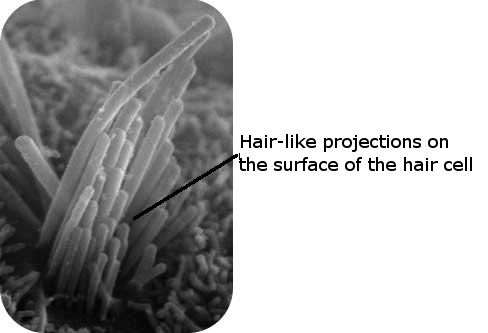17.6 听讯和耳听
章节大纲
-
This boy is cupping his hands behind his ears in order to hear better. Do you think this will help? To answer this question, you need to know more about sound, the ear, and how we hear.
::这个男孩为了听好而把双手放在耳朵后面,你觉得这样能帮助他吗?回答这个问题,你需要了解更多声音、耳朵和我们是如何听到的。The Sounds We Hear
::我们听到的声音Sound is a form of that travels in waves through matter. The ability to sense sound energy and perceive sound is called hearing . The organ that we use to sense sound energy is the ear. Almost all the structures in the ear are needed for this purpose. Together, they gather , amplify the waves, and change their to electrical signals. The electrical signals travel to the brain, which interprets them as the sounds we hear.
::声音是波浪穿梭于物质中的一种声音形式。感知声音能量和感知声音的能力被称为听力。我们用来感知声音能量的器官是耳朵。几乎所有耳部结构都需要用于此目的。它们聚集在一起,放大波浪,将其转换为电子信号。电讯号流向大脑,将它们解释为我们听到的声音。The Figure shows the three main parts of the ear: the outer, middle, and inner ear. It also shows the specific structures in each part of the ear.
::图中显示了耳朵的三个主要部分:外耳、中耳和内耳。图中还显示了耳朵每个部分的具体结构。Outer Ear
::耳外The outer ear includes the pinna, ear canal, and eardrum.
::外耳包括针头、耳道和耳膜。-
The pinna is the only part of the ear that extends outward from the head. Its position and shape make it good at catching sound waves and funneling them into the ear canal.
::Pinna是耳朵从头部向外延伸的唯一部分,它的位置和形状使它对捕捉声波和将声波输入耳道很有利。 -
The ear canal is a tube that carries sound waves into the ear. The sound waves travel through the air inside the ear canal to the eardrum.
::耳道是将声波传入耳朵的管子,声波穿过耳道的空气,进入耳鼓。 -
The eardrum is like the head of a drum. It is a thin membrane stretched tight across the end of the ear canal. The eardrum vibrates when sound waves strike it, and it sends the vibrations on to the middle ear.
::耳膜就像鼓头。它是一个薄薄的膜,紧紧伸到耳道的尽头。当耳膜响起时,耳膜会振动,震动会向中耳。
Q: How might cupping his hands behind his ears help the boy pictured in the opening image hear better?
::问:用他的手握在耳朵后, 怎样才能帮助在开张图像中描绘的男孩听到更好呢?A: His hands might help the pinna of his ears catch sound waves and direct them into the ear canal.
::答:他的手也许能帮助耳朵的针刺抓住声波,引导它们进入耳道。Middle Ear
::中耳The middle ear contains three tiny bones (ossicles) called the hammer, anvil, and stirrup. If you look at these bones in the Figure , you might notice that they resemble the objects for which they are named. The three bones transmit vibrations from the eardrum to the inner ear. The arrangement of the three bones allows them to work together as a that increases the amplitude of the waves as they pass to the inner ear.
::中间耳朵里有三个小骨头,叫做锤子、和。如果你看看图中的这些骨头,你可能会注意到它们与被命名的物体相似。三个骨头将振动从耳膜传到内耳。三个骨头的排列使它们可以一起工作,增加波浪向内耳的振幅。Q: is the maximum particles of matter move when a wave passes through them. Why would amplifying the sound waves as they pass through the middle ear improve hearing?
::问题:当波浪穿过时,物质的最大粒子会移动吗?为什么在声波穿过中耳时,声波会放大呢?A: Amplified sound waves have more energy. This increases the intensity and loudness of the sounds, so they are easier to hear.
::A: 振动声波有更大的能量。 这增加了声音的强度和响亮度, 所以它们更容易听到。Inner Ear
::内耳耳The stirrup in the middle ear passes the amplified sound waves to the inner ear through the oval window. When the oval window vibrates, it causes the cochlea to vibrate as well. The cochlea is a shell-like structure that is full of fluid and lined with nerve cells called hair cells. Each hair cell has many tiny “hairs,” as you can see in the magnified image . When the cochlea vibrates, it causes waves in the fluid inside. The waves bend the “hairs” on the hair cells, and this triggers electrical impulses. The electrical impulses travel to the brain through nerves. Only after the nerve impulses reach the brain do we hear the sound.
::中耳的马铃薯将放大的声波通过奥瓦尔窗口传到内耳。 当奥瓦尔窗口震动时, 它也会导致脑细胞震动。 脑细胞是一个充斥液体的外壳结构, 与神经细胞相配, 称为发型细胞。 每个发型细胞都有许多细小的“ 头发 ” 。 在放大的图像中可以看到这一点。 当脑细胞振动时, 它会引起内部液体的波浪。 海浪会弯曲发细胞上的“ 头发 ” , 从而触发电动脉冲。 电动脉冲会通过神经进入大脑。 只有神经脉冲到达大脑之后,我们才能听到声音。Summary
::摘要-
Sound is a form of energy that travels in waves through matter. The ear gathers and amplifies sound waves and changes them to electrical signals. The brain receives the signals and interprets them as the sounds we hear.
::声音是一种能量形式,在波浪中穿梭于物质中。 耳朵收集并放大声波,将其改变为电子信号。 大脑接收信号,并按我们听到的声音来解释。 -
The outer ear includes the pinna, ear canal, and eardrum. These structures gather sound waves, funnel them into the ear, and pass the vibrations to the middle ear.
::外耳包括针头、耳水和耳膜。 这些结构聚集了声波,将声波输入耳朵,并将震动传到中耳。 -
The middle ear contains three tiny bones that amplify the vibrations as they transmit them to the inner ear.
::中耳有三根细小的骨头 放大震动 将震动传送到内耳 -
In the inner ear, the vibrations are changed to electrical signals by hair cells lining the cochlea. The electrical signals then travel to the brain.
::在内耳,震动变成电讯号 通过毛发细胞嵌入阴道。电讯号然后传到大脑。
Review
::回顾-
Summarize how we hear sounds.
::总结一下我们听到的声音 -
Identify the structures of the outer ear and state their functions.
::查明外耳结构并说明其功能。 -
The three tiny bones of the middle ear work together as a lever. A lever is a simple machine that may increase the force applied to it. How does this relate to the function of the middle ear?
::中耳的三根小骨头作为杠杆一起工作。 杠杆是一种简单的机器,可以增加它所应用的力量。 这与中耳的功能有什么关系? -
Loud sounds can damage the hair cells lining the cochlea of the inner ear. Explain how this might affect the ability to hear sound.
::声音响起会破坏内耳内耳的毛发细胞。 解释一下这会如何影响听声音的能力。
-
The pinna is the only part of the ear that extends outward from the head. Its position and shape make it good at catching sound waves and funneling them into the ear canal.


